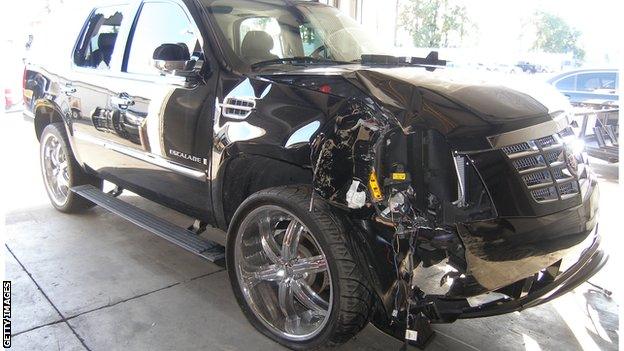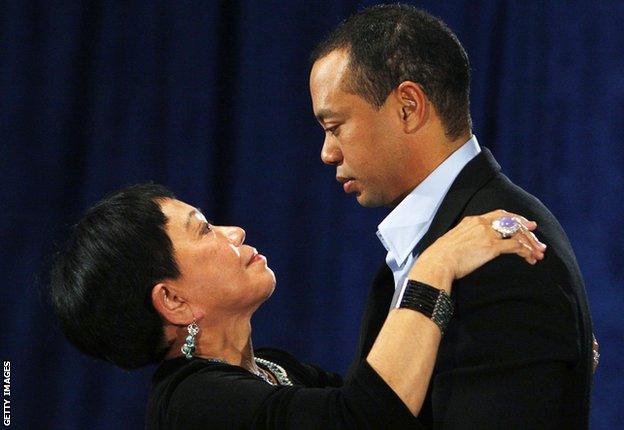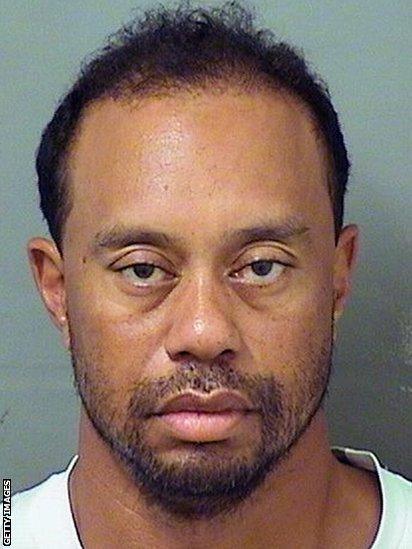Tiger Woods: His scandalous, tumultuous and redemptive decade, sparked by a car crash
- Published
- comments


Woods ended an 11-year wait to claim his 15th major with a fifth Masters title, in April 2019
Tiger Woods sped out of his Orlando driveway, across kerbs and a central reservation, collided with a fire hydrant and ploughed into a neighbour's tree.
For the world's most recognisable sportsman, this incident during the very early hours of 27 November, 2009, began a scandalous, tumultuous and spectacularly redemptive decade.
In the previous dozen years Woods had dominated golf like no other player. He won multiple majors - the championships that define careers - and reeled off tournament victories all over the world.
In the past 10 years he has won only one major but his life has turned around. He is a doting father, his sport's greatest ambassador and still a player capable of winning at the very highest level.
Comparing the most recent decade with the all-conquering period that preceded it, Rory McIlroy, who is one of his biggest rivals, says: "I think what he had to go through to get to the other side in the last 10 years is equally as impressive."
In the wake of the crash, Woods' image plumbed shameful and painful depths before eventually soaring again to hit epic highs.
That night, 10 years ago, he was surrounded by shattered glass and was groggy from a cocktail of painkillers and sleeping pills. He then lost consciousness and was ferried to hospital in an ambulance.
We were about to discover that this proud champion was, in fact, a deeply flawed individual. The crash occurred in the moments after his wife Elin had found out that her husband had been cheating.
In the days and weeks that followed, it became clear Woods had been a serial philanderer. Celebrity gossip magazines and websites were all over the story. They became an essential source for hard news, as the downfall of Woods made headlines everywhere.
He had always jealously guarded his privacy. Now the whole world knew his address: 6348 Deacon Circle, Windermere, Florida 34786.

Woods drove his SUV into a fire hydrant and tree near the entrance to his neighbour's driveway

The crash happened a week after Woods added yet another tournament victory to his glorious career. He won the Australian Masters in Melbourne, but reporters from the National Enquirer were on his tail. The American celebrity magazine suspected Woods had a secret girlfriend, Rachel Uchitel, in tow at the luxury Crown Casino and hotel.
When he returned to America he warned his wife the Enquirer would be publishing a story. He denied its allegations and multiple accounts state that he set up a call between Uchitel and Elin to reassure his wife.
Then on 26 November, Woods went to the nearby Isleworth clubhouse to spend Thanksgiving evening playing cards. He returned home, took an Ambien sleeping tablet and went to bed.
At this point Elin started to go through his mobile phone. She texted Uchitel and then called her. In the process she confirmed the affair. "I knew it," she is widely reported to have said. Elin then confronted a groggy Woods, who ran to his driveway, jumped into his Cadillac Escalade and fatefully crashed exiting his property.
No-one tracked Woods closer in 2009 than journalist Robert Lusetich. He was writing Unplayable, a book examining the character of this most guarded of golfers.
Lusetich was playing golf with friends on 27 November. The Australian reporter recalls: "One of the guys looked at his phone and he said: 'Tiger Woods has been injured in a car accident and nobody knows how bad it is.'
"It was like 'wow, that's incredible'. So I sent Steve Williams [Woods' caddie] a text. He was in New Zealand."
Williams called Mark Steinberg, Woods' long-time agent from the International Management Group.

Tiger Woods' smashed car after the 2009 crash outside his home
Lusetich heard back from Williams. "Steinberg said everything will be fine," the writer says. "And then he said: 'Don't believe anything that you're gonna hear.' That's a strange thing to say. When we saw the story from the National Enquirer it became clear that this was indeed a scandal of some magnitude."
Numerous women subsequently came forward to say they had secret relationships with the world's best golfer leaving his fans and fellow players stunned.
"I've learnt a few of the new websites this week," said Irishman Padraig Harrington, who was one of Woods' biggest rivals at the time. "It's a phenomenal story, the spotlight is massive."
When Woods was front page of the New York Post for 20 consecutive days, it beat a record set by the 11 September attacks on New York and Washington in 2001.
"I'm just amazed," admitted the 2006 US Open winner Geoff Ogilvy. "How did nobody know? Tiger Woods is quite recognisable."
Woods retreated from competitive golf - the sport he dominated with 14 majors, second only to the game's most successful player, Jack Nicklaus. He had been on track to overhaul that record of 18 major titles. It seemed only a matter of time for such a special player, one who had grown far bigger than just golf.
A black man dominating a white man's game, he could flash a million-dollar smile. Woods was the face of multinational companies such as Nike, Accenture, Gillette, Gatorade and Tag Heuer. He was the number one golfer in the world and Forbes made him sport's first billionaire.
There was a seemingly idyllic domestic scene with a photogenic wife and two young children. To the outside world he had it all, but inside there was turmoil.
And it came cascading to the fore with the relentless revelations which detailed his behaviour leading up to that infamous car crash.

Woods was released from hospital the following day and headed to Arizona where he had plastic surgery to repair his lip which had been cut in the crash. His whereabouts were known to only his closest confidants.
"I couldn't believe that Tiger Woods would be that reckless," says Lusetich. "He had basically convinced himself that he was bulletproof because of prior incidents and being able to cover them up."
On 11 December Woods released a statement which said he was taking an indefinite break from golf.
"I am deeply aware of the disappointment and hurt that my infidelity has caused to so many people, most of all my wife and children," he posted on his website.

Woods, pictured here on 21 November 2009 with his daughter, Sam, and then-wife, Elin Nordegren
After Christmas, he checked into Pine Grove Behavioural Health and Addiction Services, a facility in downtown Hattiesburg, Mississippi. It was reported he enrolled on the "Gratitude" programme to treat sex addiction.
Woods has never confirmed the nature of his treatment. "Gratitude" was designed by Dr Patrick Carnes, who first introduced the term sexual addiction into medical circles in 1983.
What seems certain is that Woods faced a brutal regime of self analysis well away from the outside world. It meant he missed the first birthday of his son Charlie.
"I can't go back to where I was," he later said. "I want to be part of my son's life and my daughter's life going forward."
Not everyone was convinced of the wisdom of Woods' treatment. A future president weighed in on Fox News: "I would recommend Tiger just call it a bad experience," said Donald Trump.
"Say bye-bye, go out, be a wonderful playboy, win tournaments and have a good life. The most important thing Tiger can do is get back on the golf course and win. This whole thing with sex rehabilitation, I'm not sure I'm a believer."
Woods returned home to Isleworth on 15 February 2010 and it was time to address the world.
Four days later, surrounded by close friends and his mother Kultida, he stood before a television camera in a room at PGA Tour headquarters in Florida. Twenty-two TV networks in the US interrupted schedules to broadcast Woods' 14-minute statement. Never had this supreme champion looked so vulnerable.
He apologised for his "irresponsible and selfish behaviour" and afterwards his mother stated: "I'm so proud to be his mother, period. He didn't do anything illegal. He didn't kill anybody."
The Open champion at the time, Stewart Cink, commented: "It was probably one of the most difficult things he's ever had to do."

Woods embraces his mother Kultida after making a statement admitting to cheating on his wife, in December 2009
The night before the apology Woods went to the range to hit his first golf balls since the scandal broke. "I hit them solid," he is reported to have told Hank Haney, his coach at the time.
He returned to action at the first major of the year, the Masters, a little under two months later and received heavy criticism from Billy Payne, chairman of Augusta National Golf Club.
"He disappointed all of us," Payne said at a remarkable chairman's news conference. "And more importantly, our kids and our grandkids. Our hero did not live up to the expectations of the role model we saw for our children."
Remarkably, Woods finished fourth in the tournament, a stunning result against the best players in the world after four tortuous months away from the game.

Within days Woods split with Haney, who subsequently wrote a tell-all book, The Big Miss. It detailed his hugely successful time coaching Woods and provided unique insights on someone so secretive of his life on and off the course.
Haney revealed Woods' obsession with the military, that the player had trained with Navy Seals and undergone punishing regimes that put enormous stress on his body.
Throughout his career he has needed multiple surgeries to correct knee, neck and back problems. "Some of the injuries, I believe, did not come from golf," says Lusetich.
"He went through that crazy phase of wanting to be a Navy Seal and did some dangerous things that hurt both his back and his knee."
Nevertheless, by 2013 Woods returned to the top of golf's world rankings. He was dominating the PGA Tour but failed to add to his major tally. No longer feared in the way that he was pre-scandal, he appeared a weaker force on major weekends.
"What happened 10 years ago, I think there was always that aura of invincibility around Tiger, so I think that showed a little bit of a vulnerable side to him," says Rory McIlroy.
"It humanised him a little bit. It is obviously very hard to come back from something like that from a mental standpoint."
But as a fellow competitor, McIlroy is also impressed by how Woods coped with the injuries that threatened his career. "He's been through the wars just with what he's had to go through physically," says the current world number two.
"I remember to this day the lunch we had in 2017 and he was sort of talking 'maybe this is it? Maybe I can't play anymore'. Then 15 months later he's winning on the PGA Tour again."
Weeks after that pessimistic lunch date, on April 20, 2017, Woods had what proved to be a career-saving back fusion operation. It was the last throw of the dice, surgery essentially aimed at making him able to be an active father and family man. If he could compete again as a golfer, that would be a bonus. "It is hard to express how much better I feel," Woods wrote a month after the procedure, his fourth and most important back surgery.
But, although he was repaired there was more shame to be endured. To cope with the rehab and previous pain, Woods was dependant on a cocktail of painkillers and sedatives. Within days of that upbeat assessment, he consumed a potentially lethal concoction of drugs.
In his system there was Vicodin for pain relief, Dilaudid - a controlled substance to combat severe pain - Xanax to ease anxiety, THC - the active ingredient in marijuana and Ambien to help sleep.
We know this because he was found by Jupiter police slumped at the wheel of his Mercedes car which was parked up with punctured tyres at around 2am on 29 May, 2017.
Video footage of an incoherent, shambolic Woods being questioned by police, handcuffed and put in cells for the night went viral. His puffy-eyed mugshot stared from the front page of pretty much every newspaper.
His DUI (driving under the influence) arrest led to prosecution for reckless driving. There was no alcohol in his system but the episode threatened uncomfortable echoes of his calamitous downfall of 2009.
"The biggest part of his comeback and the one that will get least attention from 'Camp Tiger' is that DUI," insists Lusetich. "I think that was rock bottom.

Woods' police booking photo after his arrest on suspicion of driving under the influence (DUI)
"When everyone saw him slurring, unable to walk, the great Tiger Woods and that video, there was a sadness to it. It was a tragic vision of a once great but now fallen star."
Once again Woods needed to put his life back together. He got clean and furthermore found he was able to swing a golf club with freedom. It was a revelation and meant he could do what he always did best - compete.
He came close to winning the 2018 Open at Carnoustie and the US PGA the following month. Then he won the season-ending Tour Championship, eclipsing McIlroy, his playing partner in the final round.
"And fast forward another seven months after that and he's won another major," McIlroy says. "I think it's been incredible.
"I think it shows his character, his mental capacity, his grit that he can come back after all these mishaps, whether it be personal life or the physical injuries that he's had to endure."

Woods has reconstructed his whole life since the 2009 crash. Elin divorced him in the wake of the revelations that followed. Between 2013 and 2015 he dated US skier Lindsey Vonn, someone well aware of the unique demands of life in the sporting spotlight. Now the golfer is in a long-term relationship with Erica Herman, general manager of his restaurant in Jupiter, Florida. She was there with his children to greet him at Augusta after Woods won this year's Masters.
For the champion, the fact that his children were there to witness his 15th major title, his first since the pre-scandal US Open of 2008, was the most thrilling aspect of that extraordinary triumph last April.
"I think he achieved more as a person in the last decade," says McIlroy. "Think about the wonderful job he has done as a dad to Sam and Charlie.
"That takes up a huge chunk of his time now, trying to be with them as much as possible. He doesn't travel as much because he doesn't want to be away from picking them up from school, watching their football matches or any of that.
"That side of him has really blossomed because of all the stuff he's had to go through," adds the Northern Irishman.
Earlier this month Woods won again. The Zozo Championship in Japan provided his 82nd PGA Tour success, equalling the record set by the legendary Sam Snead.
The tournament spilled into a fifth day because of weather delays. On the final morning English golfer Ian Poulter warmed up alongside Woods.

Woods is now one PGA Tour success away from setting a new titles record
"He's amazing," says the 43-year-old, who has played throughout the Woods era.
"It was as good as I've seen Tiger Woods ever hit it. Ever. It was as controlled as I've ever seen him," Poulter adds.
"To listen to the strike, watch the ball flight and to see him finish off that tournament, Tiger has still got it. He doesn't need his A game, his A minus game is still good enough to get the job done."
Woods remains deeply private but his image has softened and in a controlled way he lets more people into his life. On Golf TV, where he provides insights for subscribers, he demonstrates previously unseen charm and humour.
"He did a great job of not allowing the human being to come out and be seen," Lusetich says of Woods' former life.
"It's not like he's an open book these days but things like he does now with Golf TV, and I know they pay him, open him up more and there is more depth to him."
It has been a remarkable journey over the last decade. From rock bottom, Woods rides high once again. He is a redeemed, restored champion still more vital to his sport than any other player.
Next month he returns to Australia a different man. He captains his country in the Presidents Cup, a Ryder Cup equivalent against the rest of the world outside Europe. He is playing so well he had to pick himself as a wildcard selection.
He turns 44 at the end of this year, a leader and player, fit and fighting and a champion of more substance than the figure who was hiding so many secrets in the first part of his career.
As McIlroy says: "He's a wonderful ambassador for our game. Everyone involved in golf, you in the media, ourselves as players, equipment manufacturers - everyone benefits from Tiger Woods being at the top of golf.
"I think we should all count ourselves very lucky that he's still in that position."